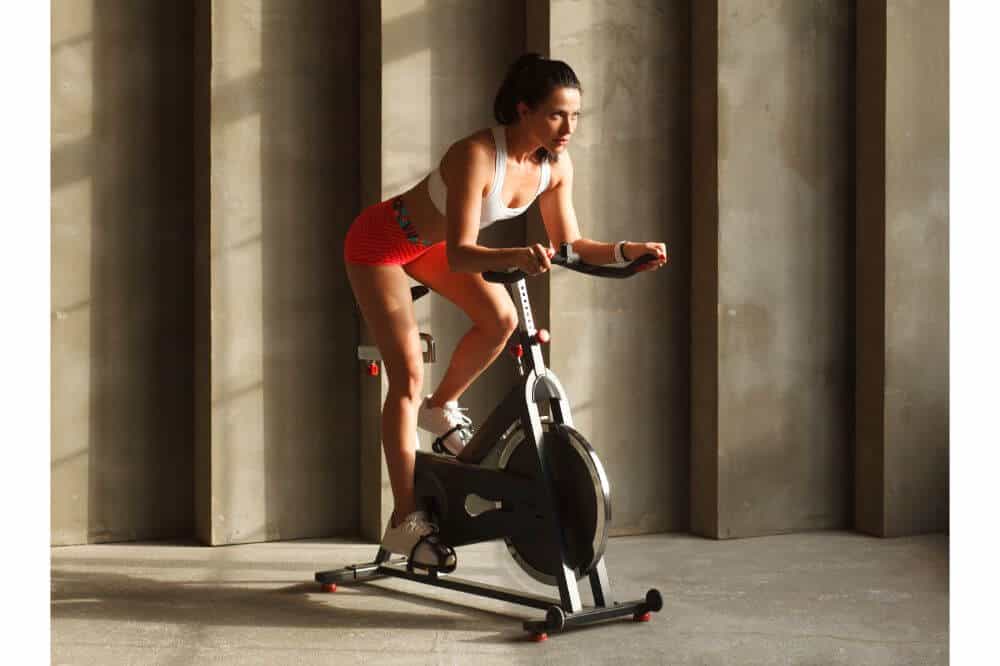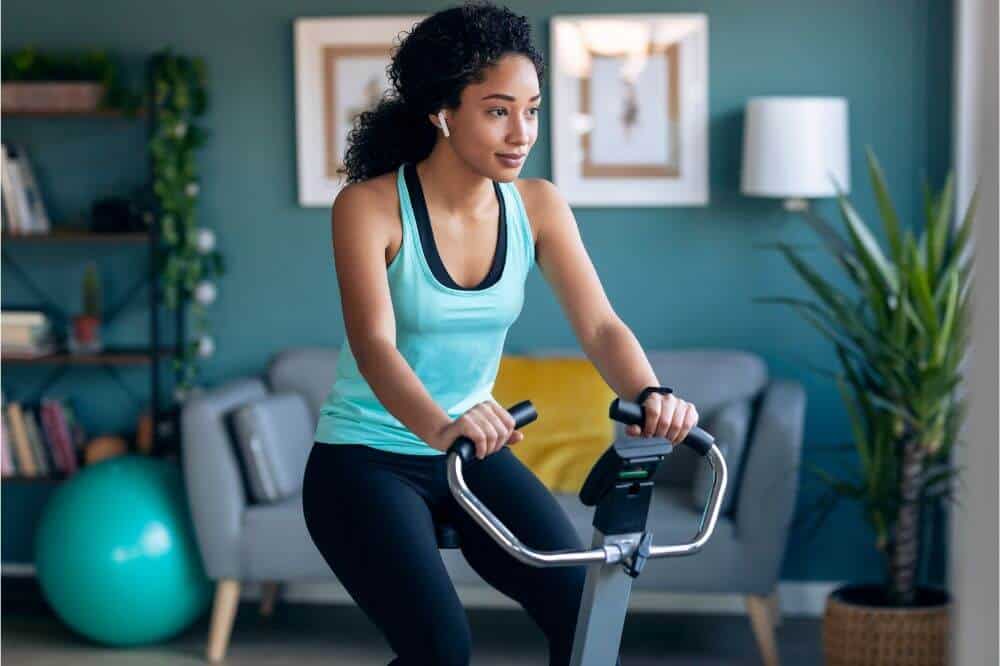Biking is one of the best forms of low-impact exercise that can be enjoyed by people of all ages and physical fitness levels. Since riding a bike outdoors isn’t always an option, many decide to get an exercise bike. However, choosing the right one can be challenging, especially if you’re new to the exercise bikes world.
Here, we’ll discuss the different types of exercise bikes and help you make the right call depending on your workout goals and physical shape.
Upright Bikes
As the name implies, upright bikes are designed to keep the users sitting in an upright position. Most people are familiar with these bikes because they resemble regular bikes the most. These bikes have pedals placed directly under the user’s body. To reach the handlebars in the front, the user has to maintain a forward-lean position.
Another key feature of upright exercise bikes is their seat, which is typically narrow to allow the legs to move without obstructions. It’s also important to point out that upright bikes don’t provide back support, which can be a deal-breaker for some users.
A study published in the National Library of Medicine confirmed the enhanced activity of the rectus femoris muscle during upright cycling. This muscle is one of the quadriceps muscles that extends and raises the knee and flexes the thigh. As such, it’s vital for our mobility.
The design of upright bikes allows users to switch between standing and sitting. Due to this, users can activate different muscle groups and enjoy different workout intensity levels. Usually, these bikes have different resistance levels, so users can adjust the difficulty.
Upright bikes strengthen the core and target the abs, back, and glutes.
While they offer incredible benefits, upright bikes are not suitable for everyone. One of their downsides is that they add stress to the joints because of the position of the pedals. Plus, the narrow seat can often become uncomfortable, especially during longer rides.
Since there are many upright bike models on the market, users can choose the features they want, from water bottle holders and LCD screens to Bluetooth connection and built-in speakers.
Recumbent Bikes
When we say “exercise bike,” we usually don’t think of recumbent bikes. Although they may seem unusual, recumbent bikes have become very popular, especially in the last few years. These bikes place the users in a laid-back reclining position.
There are numerous reasons these bikes are so popular.
First, the seat on a recumbent bike is positioned close to the ground. This makes getting in and out quite easy. Secondly, the seat is wider and more comfortable than on upright bikes. Thirdly, recumbent bikes feature back support, making them a perfect choice for beginners, the elderly, or anyone who enjoys the extra support.
Perhaps the main reason many people prefer recumbent bikes is that they don’t put extra pressure on the joints. The pedals are positioned forward, so the user’s weight is distributed over a large area. Due to the ergonomic design of recumbent bikes, the risk of injuries is much lower.
It’s important to emphasize that recumbent bikes aren’t designed to resemble regular bikes. However, this doesn’t mean they aren’t functional and effective. They are an excellent form of exercise and activate leg and back muscles. Recumbent bikes are a great option for those with joint or back issues or people recovering from an injury.
Some recumbent bikes don’t come with handlebars. This can be an advantage for those who enjoy reading a book while cycling; the downside is that the upper body is neglected.
Dual-Action Bikes
Dual-action bikes target both the lower and the upper body. They function like traditional stationary bikes with an added feature of moving handlebars connected to the pedals. Therefore, riders need to use their arms and legs to work out.
Most dual-action bikes allow the users to focus solely on legs or arms by disabling one part. Moreover, such bikes usually have an adjustable degree of participation for an increased focus on arms or legs without disabling the other.
Dual-action bikes are ideal for anyone who wants to lose weight or tone up. The key muscles you’ll engage with a dual-action bike are quads, abs, hamstrings, biceps, and triceps.
Since these bikes can put extra pressure on the knees, they may not be a good choice for those with arthritis or knee issues.
Indoor Bikes
Indoor bikes, or spin bikes, mimic the experience of real-life cycling and allow you to burn a lot of calories in a short amount of time. Most spin bikes have seats at the same level as the handles. Of course, this is adjustable, so you can choose whether you want to sit or stand while cycling.
These bikes typically feature a resistance knob in front of the seat. You can use this knob to control the difficulty level while riding, thus enhancing muscle engagement.
More advanced models of indoor bikes have built-in speakers and Bluetooth and can integrate with different workout apps. Some models have preset programs that control the resistance levels automatically.
If you like high-intensity workouts, indoor bikes are the right choice. However, these bikes may not be the right fit if you want to enjoy more casual workouts and focus on toning your muscles instead of burning calories.

Air Bikes
Air bikes resemble indoor bikes with one key difference. With indoor bikes, the resistance is controlled by a knob that the user turns as desired. With air bikes, “resistance” gets a whole new meaning.
These bikes feature a giant fan instead of a front wheel. The harder a user pedals, the more air runs through this fan, thus creating resistance. Hence, the more effort you put in, the harder it becomes to keep pedaling. If this wasn’t enough, your arms must push and pull the handles in the front. Your entire body needs to work against the bike, so it’s no surprise many call air bikes “misery machines.”
Air bikes are perfect for high-intensity interval training (HIIT). Since there are no resistance knobs, you can focus on the transition between high and low intensity using only your body. As you can assume, air bikes are ideal for burning a lot of calories.
Cardio Striders
Cardio striders resemble stair masters, recumbent bikes, and traditional exercise bikes. This may sound confusing so let’s dive in.
Traditional exercise bikes have pedals that rotate 180 degrees, which isn’t the case with cardio striders. Instead of pedals, these machines feature low steps that go up and down. The seating position resembles recumbent bikes, so the seat is closer to the ground than standard bikes.
Cardio striders provide back support and have moving handlebars so that users can work on the upper and lower body without putting pressure on their joints or feet.
Which Type of Exercise Bike Should You Choose?
Since different exercise bikes have different purposes, it’s impossible to say one is better than the other. Your choice will depend on several factors. Besides your budget, you need to consider the functions, portability, connectivity features, etc. Most importantly, you must think about your goals.
Firstly, you should determine whether you want to ride your bike every day or only occasionally. If you want the latter, there’s no need to invest in a high-end, expensive bike. On the other hand, if you want to work out every day, it may be wise to get a top-quality bike with extra features that will improve your experience.
Then, you should consider the available space in your home. If you have a home gym, space probably isn’t an issue. However, if you live in a small apartment, you probably don’t want an exercise bike that will take up half of your living room. In such cases, it’s best to look for foldable bikes that can be stored away in a closet when you’re not using them.
Now it’s time to focus on your goals.
Do you want to lose weight, strengthen your core, tighten your arms, or get a whole-body workout? What you want to achieve dictates the type of bike you should get.
For example, air bikes are an excellent choice if you want to enjoy high-intensity interval workouts. Those who want to exercise without putting pressure on the joints should choose recumbent bikes. Dual-action bikes can be a great option if you want to engage both the upper and the lower body.
The next step is to consider extra features that may improve your experience.
For example, an LCD screen that shows your workout stats in real-time. Information like speed, time, calories burned, and distance help you stay on top of your workout, track progress over time, and, if necessary, adjust the intensity.
An LCD screen used to be featured only on high-end exercise bikes in the past. Nowadays, this is a common feature that most users find valuable.
If you’re a beginner, you may want a bike that can connect to different workout apps. Such apps offer on-demand workouts that can guide you in the beginning until you figure out what works best for you. Since these bikes are often expensive, you can look for those with a tablet holder. Although you may not be able to transfer your workout data to the app, you can still follow on-demand workouts.
Choose the Right Bike Carefully
Although they may seem similar, different types of exercise bikes have different purposes. Not all exercise bikes are appropriate for all users, which is why you should be careful when purchasing one. There are many factors to consider before you buy it, and we know how overwhelming the process can get. If you’re unsure what exercise bike would work for you, don’t hesitate to talk to experts who will help you find the right one.

